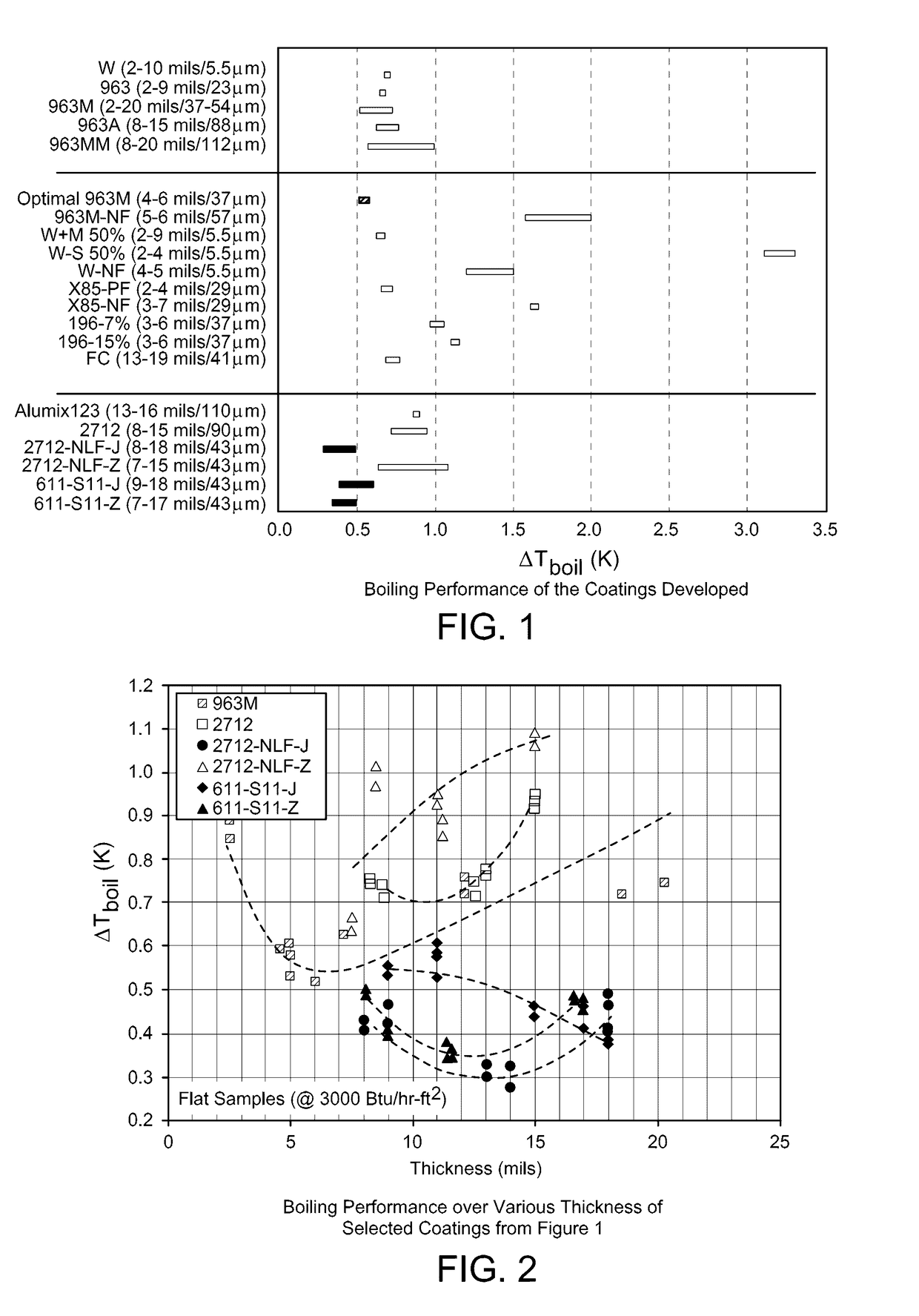Porous coatings
a technology of porous coatings and coating compositions, applied in the direction of sustainable manufacturing/processing, mechanical equipment, lighting and heating apparatus, etc., can solve the problems of conventional porous coatings suffering from an unacceptably high t, 960, inefficiency of porous coatings,
- Summary
- Abstract
- Description
- Claims
- Application Information
AI Technical Summary
Benefits of technology
Problems solved by technology
Method used
Image
Examples
example 1
611-S11-Z
[0045]Coating 611-S 11-Z was prepared from a slurry having the following constituents: 66 wt % aluminum powder (commercially available as Ampal® 611); 0.67 wt % Mg; 0.34 wt % Sn; 2 wt % PVB; and 30 wt % IPA solvent. The median particle size was approximately 43 μm. The slurry constituents were thoroughly mixed. The slurry was then applied onto the substrate by dip coating.
[0046]A drying process for IPA solvent evaporation was performed at ambient temperature for about 30 minutes. Next, the binder PVB was burned by heating the coating in a furnace at 450° C. for 1 hour in air, followed by sintering at 580° C. for 1 hour in nitrogen. The microstructure was visually observed SEM as shown in FIG. 4. SEM as shown in FIG. 4. The resultant coating morphology is shown in FIG. 4. No coating defects as shown in FIG. 6a, 6b, 6c, 6d, or 6e were observed. The median pore size was about 10 μm and the pore size distribution was determined to be normally distributed as shown in FIG. 3a.
example 2
611-S11-Z Coating Performance
[0047]The porous coating of Example 1 was evaluated for performance by conducting the pool boiling experiment as described above. The test heater assembly (Table 1) was prepared with the porous coating of Example 1. The heater assembly was then loaded inside a dewar as shown in FIG. 7. The pool boiling experiment was initiated as shown in FIG. 8. The boiling ΔT was obtained at a heat flux of 3000 Btu / hr-ft2. The results for 611-S11-Z are shown in FIG. 1.
[0048]Additional boiling experiment tests using 611-S11-Z were conducted to evaluate the effects of coating thickness. The results are shown in FIG. 2. 611-S11-Z displayed the best results at a coating thickness of about 330 μm. 611-S11-Z outperformed the other screened coatings at all thicknesses.
example 3
2712-NLF-J
[0049]Coating 2712-NLF-J was prepared from a slurry having the following constituents: 55 wt % commercially available Ampal® 2712 aluminum alloy powder containing 0.8-1.2 wt % Mg; 3.6-4.0 wt % Cu; 0.6-0.9 wt % Si; 44 wt % ethanol; 0.27 wt % hydroxypropyl cellulose; and 1-2 drops of a defoaming agent (commercially available as MD-20). The median particle size was approximately 43 μm. The slurry constituents were thoroughly mixed. The slurry was then applied onto the substrate by dip coating.
[0050]Drying process for solvent evaporation was performed at ambient temperature for about 30 minutes. Next, the binder was burned by heating the coating in a furnace at 450° C. for 1 hour in air, followed by sintering at 620° C. for 1 hour in nitrogen. The microstructure was visually observed by SEM as shown in FIG. 5. The resultant coating morphology is shown in FIG. 5. No coating defects as shown in FIG. 6a, 6b, 6c, 6d, 6e or 6f were observed. The median pore size was about 10 μm and...
PUM
| Property | Measurement | Unit |
|---|---|---|
| Diameter | aaaaa | aaaaa |
| Length | aaaaa | aaaaa |
| Length | aaaaa | aaaaa |
Abstract
Description
Claims
Application Information
 Login to View More
Login to View More - R&D
- Intellectual Property
- Life Sciences
- Materials
- Tech Scout
- Unparalleled Data Quality
- Higher Quality Content
- 60% Fewer Hallucinations
Browse by: Latest US Patents, China's latest patents, Technical Efficacy Thesaurus, Application Domain, Technology Topic, Popular Technical Reports.
© 2025 PatSnap. All rights reserved.Legal|Privacy policy|Modern Slavery Act Transparency Statement|Sitemap|About US| Contact US: help@patsnap.com



